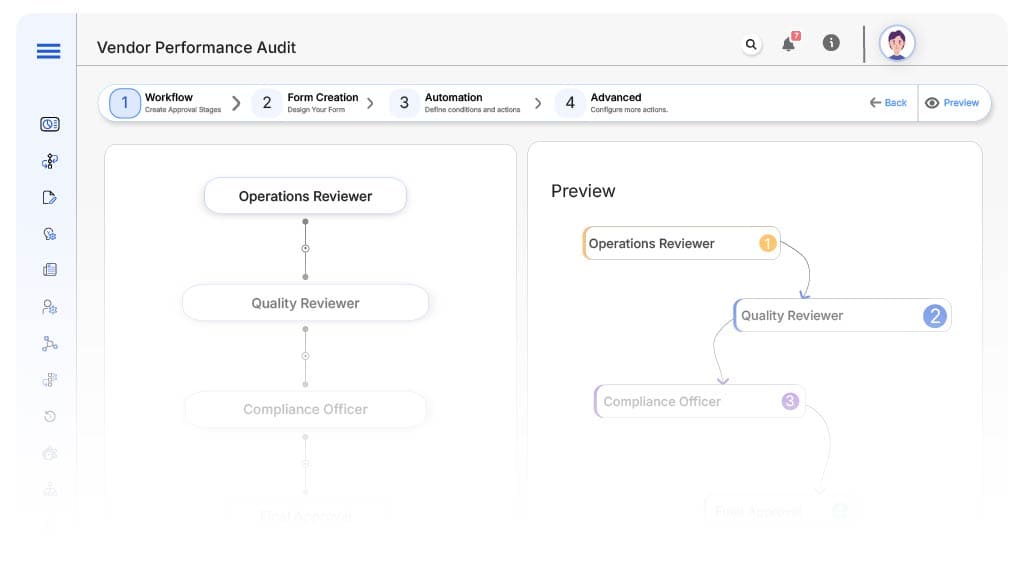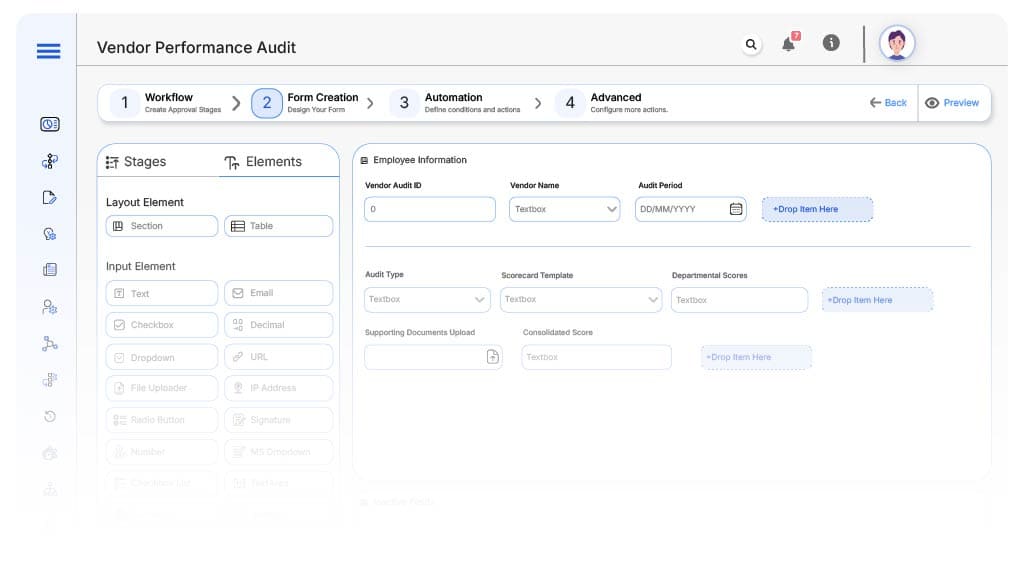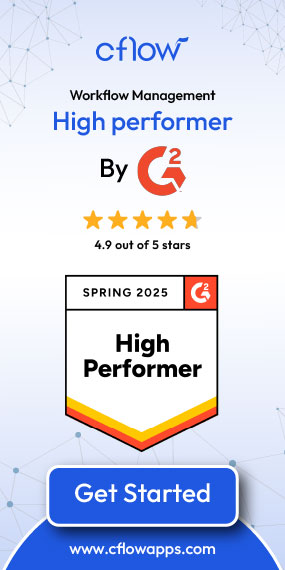- Cflow
- Vendor Performance Audit Automation
Vendor Performance Audit Automation

Clow Team

Evaluating vendor performance is critical for maintaining supply chain reliability and ensuring contract compliance. Manual vendor audits often result in inconsistent scoring, subjective evaluations, and missed improvement opportunities. Research shows that organizations using automated vendor audit systems improve supplier compliance by 60%.
Without automation, procurement teams, compliance officers, and quality managers spend too much time coordinating audits, chasing data, and standardizing reports. This guide walks you through exactly how Cflow automates Vendor Performance Audits, from audit scheduling to final scoring.
What Is Vendor Performance Audit Process?
The Vendor Performance Audit Process evaluates suppliers on delivery timelines, service quality, contract adherence, and responsiveness. It ensures vendors meet expectations defined in service level agreements (SLAs) and contract KPIs.
This process typically includes periodic reviews, standardized scoring, cross-functional inputs, and final sign-off by procurement or quality leaders. Audits may be triggered quarterly or post-project.
Industry research shows that organizations conducting structured vendor audits reduce procurement-related risks by 50% and enhance vendor accountability.
Why Vendor Performance Audit Automation Matters?
Procurement Reliability
Compliance Adherence
Standardized Evaluation
Continuous Improvement
Audit Traceability
Key Benefits of Automating Vendor Performance Audit with Cflow
- Centralized Audit Request and Tracking: Cflow standardizes how vendor audits are initiated, capturing vendor details, audit type, review period, and performance metrics in a unified form. This reduces manual errors and enables real-time tracking of audit progress. Stakeholders can monitor which vendors are under review and ensure audits are completed on time.
- Criteria-Based Routing for Review: Audit workflows are dynamically routed based on vendor tier, contract value, or past performance. High-risk or strategic vendors go through additional layers of review such as compliance and legal. This ensures each audit receives the right level of scrutiny based on business criticality.
- Documented Evaluations and Findings: Cflow allows reviewers to upload findings, rate KPIs, and log corrective actions within the system. All feedback is stored under each vendor’s audit record, enabling comparisons over time and supporting supplier development. This strengthens accountability and simplifies future vendor negotiations or decisions.
- Real-Time Notifications and Escalation Alerts: Automated alerts notify teams when reviews are pending or responses are overdue. Escalation logic ensures delays in performance evaluations don’t impact renewals or risk assessments. Cflow helps maintain audit discipline and keeps all departments aligned throughout the vendor performance review process.
- Full Audit Trail and Historical Benchmarking: Every action, comment, and scorecard is timestamped and archived by Cflow, creating a comprehensive audit trail. This history allows organizations to benchmark vendor performance across quarters or years and support strategic sourcing decisions. The audit logs are invaluable for internal governance and regulatory reporting.
Get the best value for money with Cflow
User Roles & Permissions
Procurement Manager (Initiator)
- Responsibilities: Initiates vendor audit based on timeline or project completion. Selects vendor and sets evaluation scope.
- Cflow Permission Level: Submit Form.
- Mapping: “Procurement Team.”
Operations Reviewer
- Responsibilities: Scores vendor’s responsiveness, coordination, and delivery compliance.
- Cflow Permission Level: Approve/Reject.
- Mapping: “Operations Group.”
Quality Reviewer
- Responsibilities: Evaluates technical quality, issue handling, and documentation.
- Cflow Permission Level: Approve/Reject.
- Mapping: “Quality Group.”
Compliance Officer
- Responsibilities: Reviews adherence to SLAs, risk mitigation, and contractual terms.
- Cflow Permission Level: Approve/Reject.
- Mapping: “Compliance Team.”
Head of Procurement (Final Approver)
- Responsibilities: Reviews consolidated scores and final comments before publishing results.
- Cflow Permission Level: Approve/Reject.
- Mapping: “Leadership Board.”
Discover why teams choose Cflow
Form Design & Field Definitions

Field Label: Vendor Audit ID
- Type: Autonumber
- Auto-Populate Rules: Created at submission.
Field Label: Vendor Name
- Type: Dropdown
- Logic/Rules: Linked to approved vendor master list.
Field Label: Audit Period
- Type: Date Range Picker
- Logic/Rules: Required.
Field Label: Audit Type
- Type: Dropdown (Scheduled, Ad-Hoc, Project-Based)
- Logic/Rules: Drives audit scope.
Field Label: Scorecard Template
- Type: Dropdown
- Logic/Rules: Determines scoring sections.
Field Label: Departmental Scores
- Type: Repeater Field
- Logic/Rules: Each department inputs scores independently.
Field Label: Supporting Documents Upload
- Type: File Upload
- Logic/Rules: Mandatory for final submission.
Field Label: Consolidated Score
- Type: Calculated Field
- Logic/Rules: Based on weight distribution.
Field Label: Final Comments
- Type: Text Area
- Logic/Rules: Optional before final approval.
Transform your Workflow with AI fusion
Approval Flow & Routing Logic

Submission → Operations Reviewer
- Status Name: Pending Operational Scoring
- Notification Template: “Please evaluate vendor performance from operations perspective.”
- On Approve: Move to Quality Reviewer.
- On Reject: Return to Procurement Manager.
- Escalation: Notify Ops Head if no response in 24 hours.
Operations Reviewer → Quality Reviewer
- Status Name: Pending Quality Scoring
- Notification Template: “Please evaluate technical quality and documentation.”
- On Approve: Move to Compliance Officer.
- On Reject: Return to Operations Reviewer.
- Escalation: Notify QA Lead if delayed.
Quality Reviewer → Compliance Officer
- Status Name: Pending Compliance Review
- Notification Template: “Review vendor contract adherence and SLA terms.”
- On Approve: Move to Head of Procurement.
- On Reject: Return to Quality Reviewer.
- Escalation: Alert Compliance Manager after 24 hours.
Compliance Officer → Head of Procurement
- Status Name: Pending Final Audit Approval
- Notification Template: “Final audit score and notes ready for approval.”
- On Approve: Close audit, mark completed.
- On Reject: Return to Compliance Officer.
- Escalation: Escalate to Leadership Board.
Transform your AI-powered approvals
Implementation Steps in Cflow
Create a new workflow
Design the form
Set up User Roles/Groups
Build the process flow diagram
Configure notifications
Set scoring logic
Save and publish workflow
Activate.
Test
Adjust logic if needed
Go live
Example Journey: Q2 Logistics Vendor Review
FAQ's
Monthly, quarterly, or post-project, schedule can be defined based on vendor type.
Yes. Templates can be customized per department and audit type.
Absolutely. Download PDFs or Excel reports for sharing.
Yes. Use dashboards to monitor trends and highlight consistent performers.
Unleash the full potential of your AI-powered Workflow

